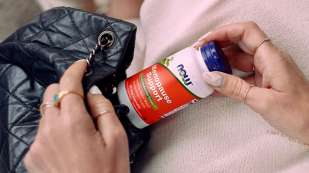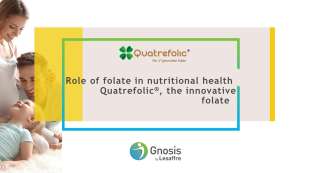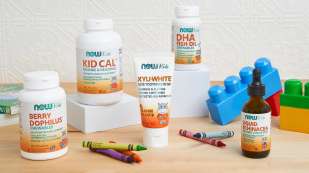25% off a $40+ order with coupon code:
FLOWERS†Niacin Forms and Safety

An essential component of many dietary supplements
Niacin, or vitamin B3, is an essential component of many dietary supplements including daily multivitamins and B-complex vitamins. It is also naturally found in some foods including meat, fish, nuts, legumes, and grains or is added to foods like breakfast cereals and breads. The two forms of niacin found in foods and supplements are nicotinic acid and niacinamide, also known as nicotinamide. The body is also able to convert the amino acid tryptophan into nicotinamide.
What are the benefits of niacin?
In the body, niacin acts as a coenzyme, which means it helps some enzymes function at their optimal potential. More than 400 enzymes depend on niacin for various reactions, including helping to convert nutrients into energy, cholesterol, and fat metabolism, and building and repairing DNA.* Niacin is water soluble, and excess amounts that are not needed by the body are eliminated in the urine.
How much niacin do we need?
The amount of niacin needed depends on the age, sex, and physical health of individuals. The average daily recommended amount is 16 mg per day (recommended Daily Value, DV) for adult men, 18 mg for pregnant teens and women, which could be consumed from any source. The Tolerable Upper Intake Level (UL) for niacin is set at 35 mg per day, mainly based on one form: nicotinic acid, which could cause an uncomfortable “niacin flush”.
What happens if there is not enough niacin in the body?
Pellagra is the disease caused by severe niacin deficiency. It is very rare in the United States.
However, some individuals in the United States have a low niacin status, which means that even though they do not have pellagra, they still do not have enough niacin in the body for niacin-dependent enzymes to function at their optimal level. People who do not consume enough riboflavin (vitamin B2), pyridoxine (vitamin B6), or iron convert less tryptophan to nicotinamide, which can further niacin deficiency.
What is a “niacin flush”?
The “niacin flush” is a reddening of the skin, associated with burning and itching sensations following the oral ingestion of nicotinic acid, it typically occurs within 10 to 20 minutes after the ingestion and lasts about 60 to 90 minutes. This is a temporary phenomenon, with many individuals developing a tolerance to the flushing within a week of regular usage. Sustained release formulations of nicotinic acid help minimize the niacin flush.
The niacin flush can be mitigated by orally taking aspirin at least 30 minutes before ingesting nicotinic acid. To reduce the intensity of niacin flushing, it is recommended to start supplementation with a low dose and gradually increase it over several weeks. It is also helpful to consume nicotinic acid with food as it helps diminish the intensity of the flush.
Are there any “flush-free” forms of niacin?
Niacinamide (nicotinamide) is a form of niacin that does not cause flushing, nor does inositol hexanicotinate, another form of niacin often found in dietary supplements.
Most of the niacin found in food is in the form of nicotinic acid and nicotinamide; some foods also contain small amounts of NAD and NADP, which are the coenzyme-active forms of niacin. The body also converts tryptophan to NAD, hence tryptophan is also considered a dietary source of niacin. These forms are not known to trigger “niacin flush”.
What forms of niacin are we using in our products?
NOW® uses flush-free forms, niacinamide (nicotinamide), and inositol hexanicotinate in most of our niacin-containing products. A few formulas have NAD, in small amounts, and this form is also considered to be safe and flush-free.
We still use nicotinic acid in a few formulas: Niacin 500 mg, Niacin 500 mg Sustained Release, True Balance™, and Energy.
Can chromium nicotinate glycinate or polynicotinate trigger a “niacin flush”?
NOW uses these forms of chromium in a variety of products, as it has been shown that combining nicotinic acid with chromium increases its efficacy. Combining nicotinic acid with chromium only add a minimal amount of nicotinic acid to the finished product and is unlikely to trigger a “niacin flush”.
Could I experience a “niacin flush” when taking niacin-containing NOW supplements that have a higher suggested usage?
Based on published literature, the forms and amounts of niacin present in most NOW supplements should not cause any significant adverse effects when used as directed on the label, even when taking those forms of niacin in potencies above the 35 mg/day UL set for all forms of niacin.
Using higher amounts than recommended on a product label should only be done under the supervision of a healthcare professional, who can monitor the person for potential signs of toxicity. Adverse effects (other than flushing) have been observed at doses of 1,500 mg/day for nicotinic acid and 3,000 mg/day for niacinamide, far above the 35 mg/day UL set for all forms of niacin.
NOW offers several forms of niacin at different potencies, including some above the 35 mg/day UL set for all forms of niacin which was set up mainly because of the “niacin flush”. Because nicotinic acid and niacinamide have slightly different functions, it is important for all forms of niacin to be available in dietary supplements. Individuals using our niacin supplements can work with their healthcare practitioners to decide which form and potency of niacin is best for them and will offer the best results for their specific health needs.
For more information: https://ods.od.nih.gov/factsheets/Niacin-Consumer/
*These statements have not been evaluated by the Food and Drug Administration. These products are not intended to diagnose, treat, cure or prevent any disease.











